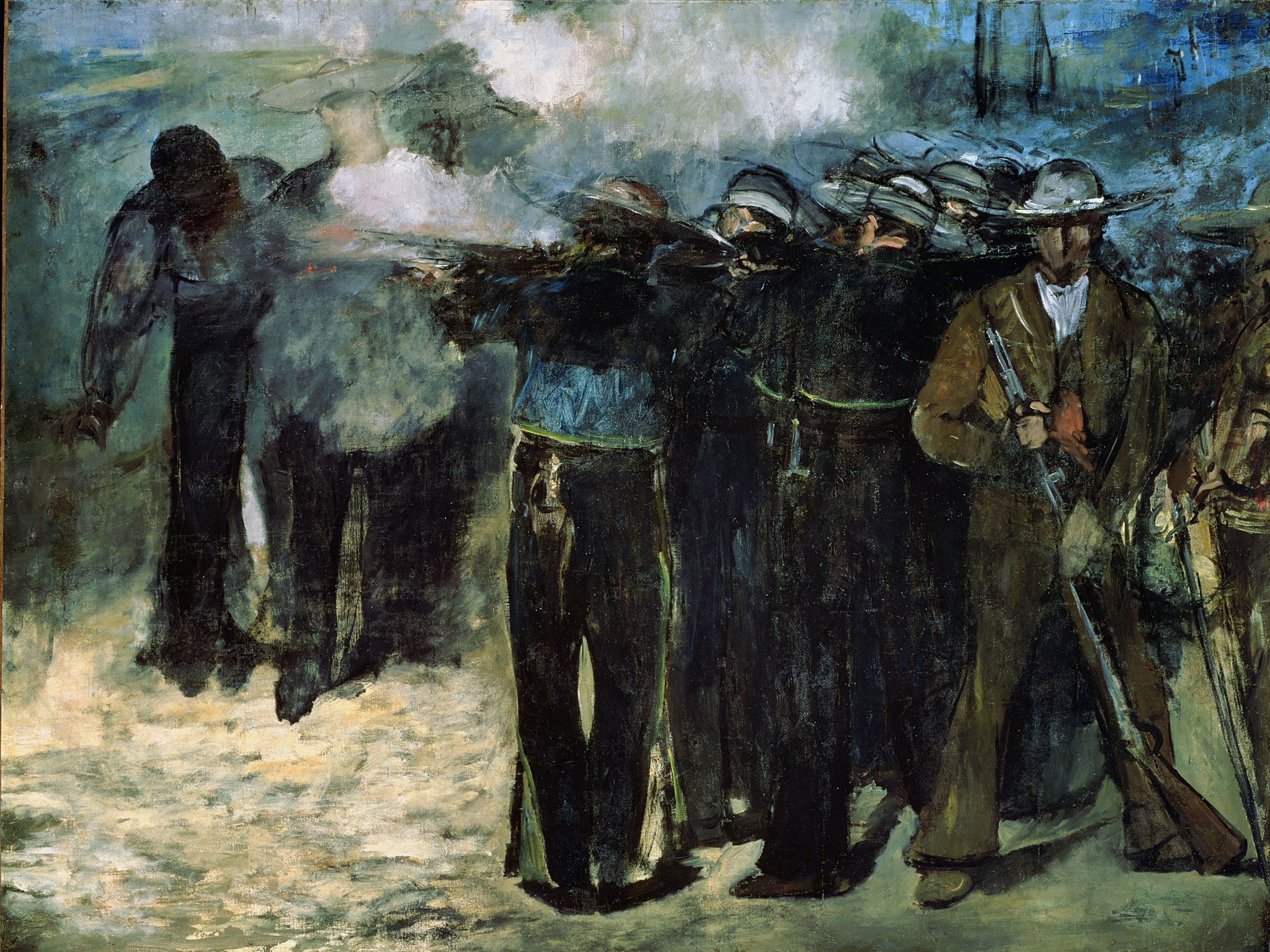Great works: The Execution of Emperor Maximilian, 1867, by Édouard Manet
Museum of Fine Arts, Boston

A lack of finish in a painting troubles us. It can also exhilarate, opening up various interpretative possibilities which are never quite realised. We saw a large, unfinished equestrian portrait by Édouard Manet in the recent retrospective of his portraits at London's Royal Academy. Its presence there was no cause for celebration. It was far too unfinished. Manet would have been appalled to see it on public display. In short, it looked like a filler.
This painting exists in three versions. One is in Boston, another in London, and a third in Mannheim. Two of these versions are either fragmentary or incomplete. The third is finished, but the almost polished representation of the story that it tells falls short of giving us much imaginative satisfaction. Why? Because Manet, in that final version, has shown us too much. It is too finically perfected in its execution.
And yet Manet drove himself on to do it, to bring it to a successful conclusion in the way that he did for a very particular reason. He was striving to rise to an occasion, which was the depiction of a subject of great public importance – the killing of an emperor and his two generals by firing squad. It was the kind of picture that would surely make his name at the Paris Salon. Alas, the Salon rejected it even before it was officially entered. Manet would never become the history painter he perhaps only half-wanted to be.
The first version of the three – which is the one you can see on this page – feels the most urgently alive. It has the stink of reality about it for all that it looks a bit rough and ready in its execution. There is a clutter of bodies here. Nothing is orderly or especially well managed. The soldiers feel nervily close-packed. We can smell the stink of all that rising smoke after the collective discharge of those firearms. The fug that hangs above the scene resembles an old-time London smog.
These problems – a sense of sketchiness, hurry and even unclarity – were unavoidable. They also explain why he never finished the painting. Manet was struggling to keep up with the present. He was painting it as news of the assassination was reaching him through the press. He had to remain faithful to the reported details as they came in. Unfortunately, some of these so called facts were then contradicted by further so called facts. Such are the difficulties presented to an artist when he tries his hand at making a painting which is also a timely documentary.
The subject was politically controversial. Maximilian, sometime emperor of Mexico, had been executed on the orders of the man who supplanted him. Napoleon III of France – a man heartily disliked by Manet – was in part to blame for the emperor's vulnerability. He had withdrawn French troops from the country, leaving him naked in the face of aggression.
Manet found himself hugely drawn to the subject when he first read about it in a newspaper in July 1867. He had recently seen Goya's The Third of May at the Prado in Madrid, another great painting about a public execution by firing squad – and he felt a need to respond to this new atrocity. But, as mentioned, he felt hobbled by a lack of accurate information. What exactly were these soldiers wearing?
First, guessing, he painted them in sombreros, only to discover a little later that they had in fact been wearing képis as headgear – which is why there is a mixture of the two here. The three men who are being executed are featureless: the general to the left of the emperor himself appears to be wearing a black hood, thus guaranteeing anonymity. They are featureless because Manet had no idea what they looked like.
And yet this featurelessness seems to work. It makes our pulses race. There is something chillingly effective about this hoodedness, this blanking out. It seems to speak for – and to appeal to – us all. It seems to summarise the terrible, sudden, wholly indiscriminate – and perhaps wholly unjust – onset of suffering.
By comparison, the faces of the three men in the final version of the painting, so docile, so blandly puppet-like, go to their deaths woodenly. We do not find ourselves reaching out to them, suffering with them. Manet knew too much about them by then. He no longer had the space to do a bit of feverishly anxious dreaming. The careful examination of a photograph or two had part-snuffed out all that inward terror.
About the artist: Édouard Manet (1832-83)
The French painter Édouard Manet was born into a family of great prosperity – his mother was the daughter of a diplomat and god-daughter of the Swedish Crown Prince – in the Rue Bonaparte in Paris. His father was a French judge who expected him to pursue a career in the law. In defiance of his parents' wishes, he devoted himself to painting, provoking public ridicule by depicting modernity as he saw it, though he maintained throughout his life a craving for public recognition. He died at the age of 51 of rheumatism and untreated syphilis. Days before his death, his gangrenous foot was amputated.
Subscribe to Independent Premium to bookmark this article
Want to bookmark your favourite articles and stories to read or reference later? Start your Independent Premium subscription today.

Join our commenting forum
Join thought-provoking conversations, follow other Independent readers and see their replies